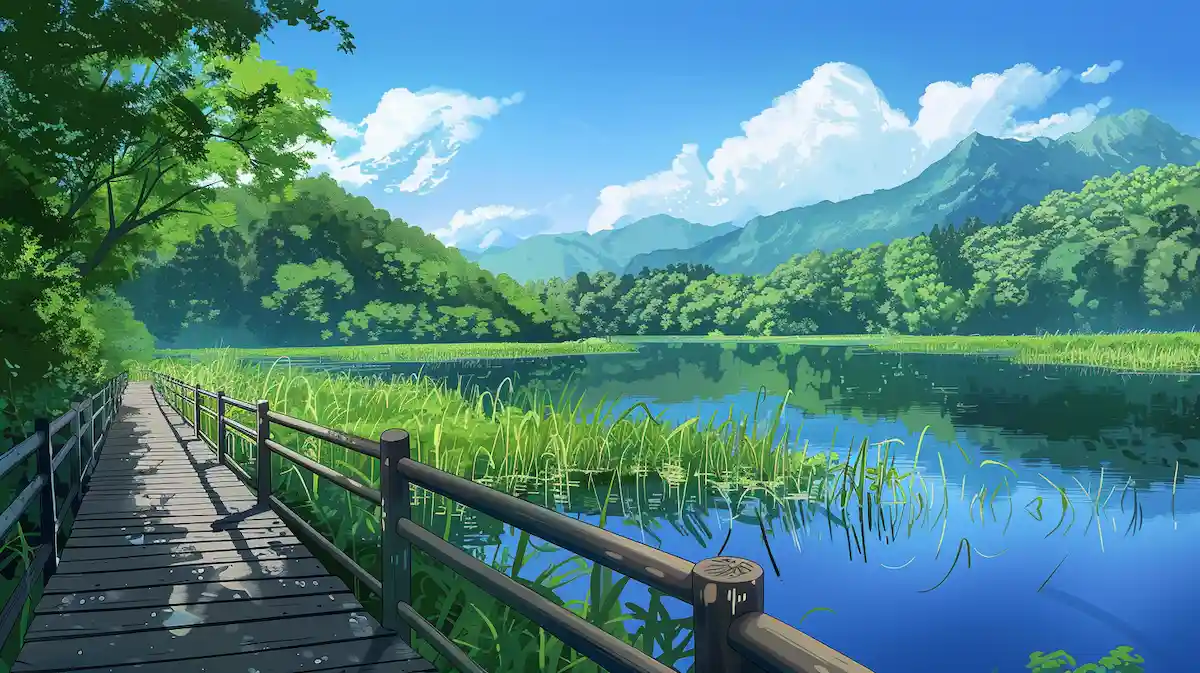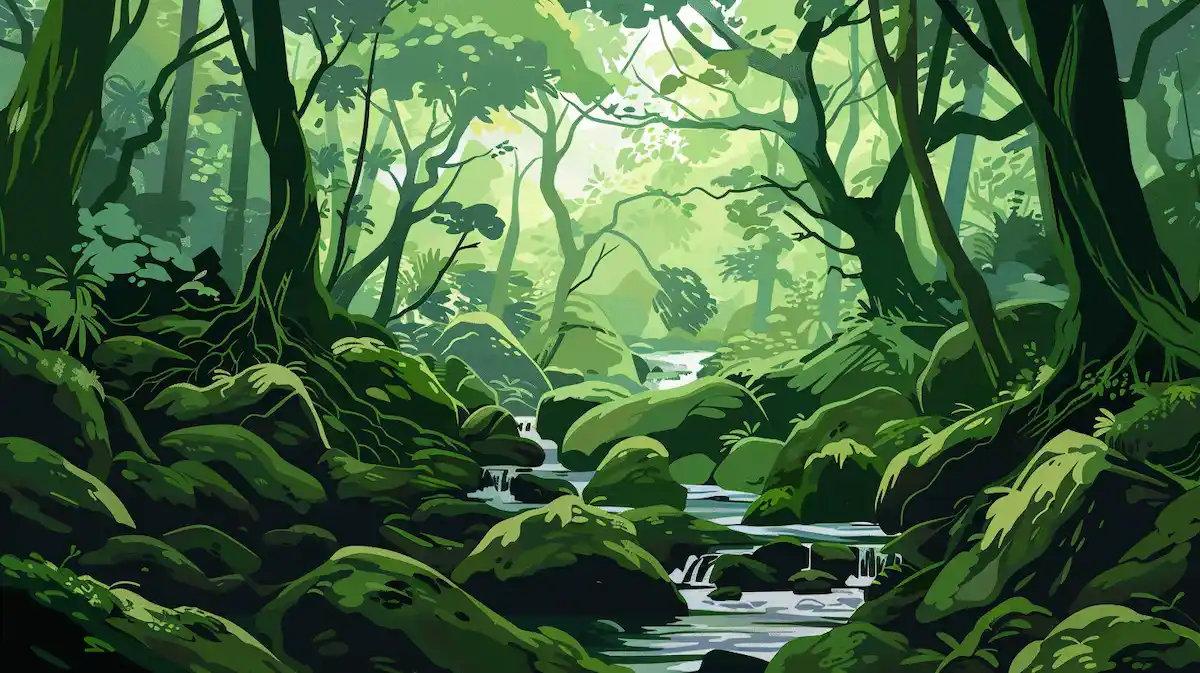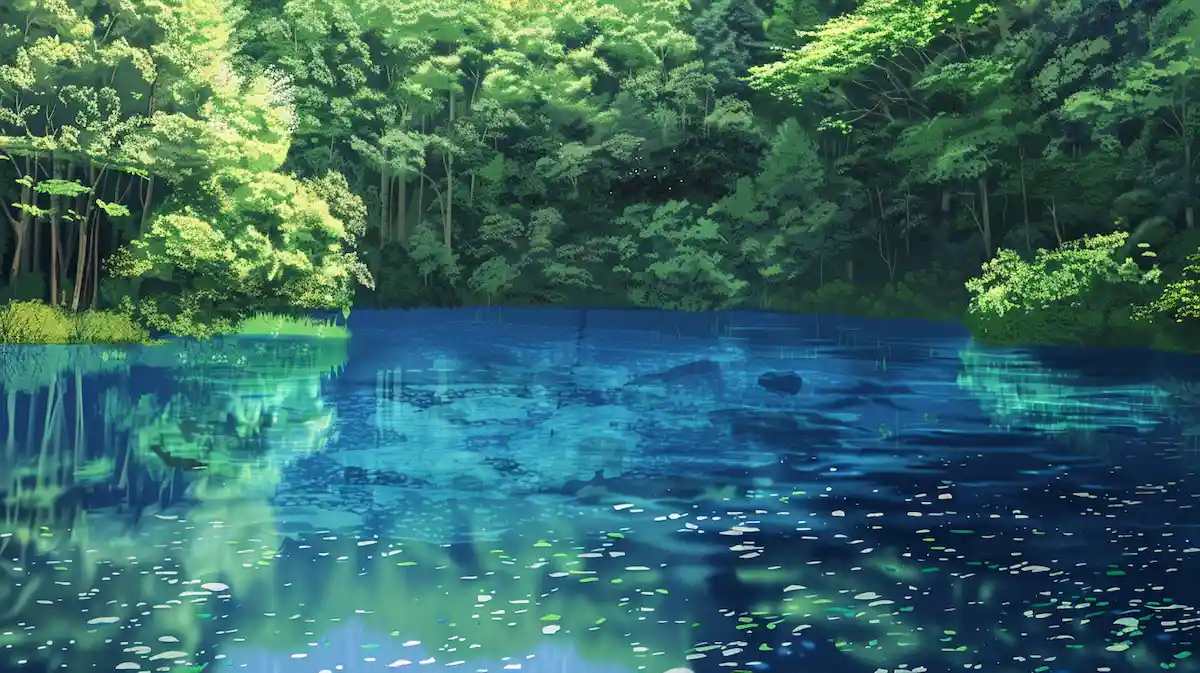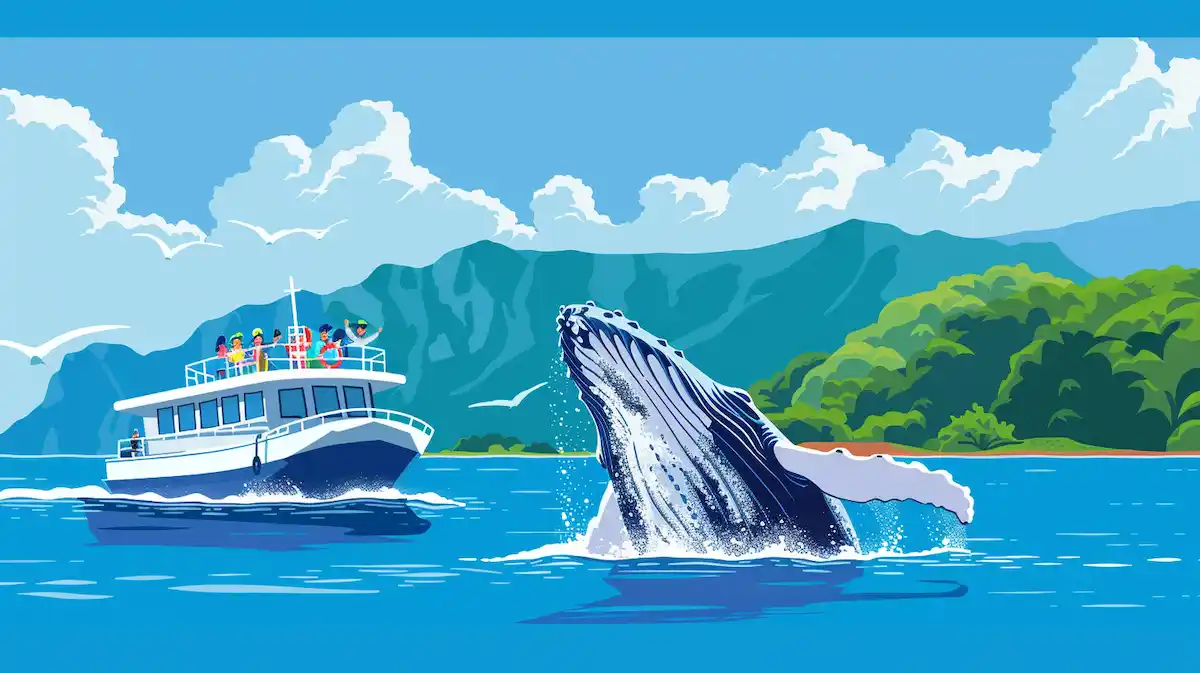小笠原諸島を英語で説明・紹介するための基本情報と、英会話に役立つ表現をシンプルでわかりやすい英語で紹介します。
英会話ダイアローグ・関連情報・10の質問を通して、世界自然遺産の小笠原諸島に関する英語表現を学びます。
英語
英会話ダイアローグを読む前に知っておくと良い前提知識と情報です。
- 小笠原諸島の基本情報
- 東京の南約1,000キロの太平洋上に位置する島々
- ユネスコの世界自然遺産に登録されている
- 独特の生態系を持ち、「東洋のガラパゴス」とも呼ばれ、固有種の動植物が多く見られる
- 主な有人島は父島と母島
- アクセス方法
- 東京の竹芝桟橋から定期船「おがさわら丸」で約24時間かかる
- 観光の見どころ
- ホエールウォッチングやダイビングなどのマリンアクティビティが楽しめる
- クジラは特に冬から春にかけて見ることができる
- 観光シーズン
- 春から初夏、そして秋が観光に適している
2人が小笠原諸島について話しています。
世界自然遺産の小笠原諸島の位置や特徴、自然の豊かさ、ホエールウォッチングや島でのアクティビティなどを話題にしています。
会話 / dialogue

Hey Key, have you ever heard of the Ogasawara Islands?

Oh, you mean the ones south of Tokyo? I’ve heard about them, but I don’t know much. Why do you ask?

I’ve been really interested in them lately. They’re about 1,000 kilometers from Tokyo and part of the Tokyo Metropolitan area, but they feel so remote.

That’s quite far! How do you even get there?

That’s part of the adventure. There’s no airport, so the only way to go is by a ferry called the Ogasawara Maru. It takes around 24 hours from Takeshiba Pier in Tokyo to Chichijima.

Wow, 24 hours on a boat! But I guess you can enjoy the ocean views along the way.

Exactly. Some people even see dolphins or whales during the trip. The islands are sometimes called the “Galapagos of the East” because of all the unique species that live there.

That’s pretty amazing. I read somewhere that they’re a UNESCO World Heritage site, right?

Yeah, they’ve been a World Natural Heritage site since 2011. The islands have a lot of endemic plants and animals, which means they can’t be found anywhere else in the world.

That sounds fascinating. When’s the best time to visit?

From what I’ve learned, spring to early summer and autumn are the best times to go. The weather is nice, and you can do things like snorkeling, diving, and even whale watching.

I’ve always wanted to go whale watching. What kind of whales can you see there?

In winter and early spring, you can spot humpback whales, and sometimes sperm whales in the summer. The islands are a great spot for marine life.

Sounds like a paradise for nature lovers. What else can you do there besides whale watching?

Well, the beaches are beautiful, and there are hiking trails with stunning views. You can also explore the forests, which are home to some really rare species of plants and birds. It’s great for people who love the outdoors.

It sounds perfect for hiking and exploring. But what about the history? Anything interesting?

Actually, yeah. The islands have a mix of Japanese and Western history. After WWII, the islands were under U.S. control for 23 years before returning to Japan. There are also ruins from the war you can explore.

That’s really interesting. I didn’t expect them to have such a unique history. Are there any other islands besides Chichijima?

Yes, Hahajima is the other inhabited island. It’s smaller but also worth visiting. If you go, you’ll need to take another ferry from Chichijima.

So, it sounds like a pretty exclusive place to visit. You’d have to plan well in advance, especially with the ferry schedules.

Exactly. Since the ferry only runs once every few days, you really have to plan your trip carefully. But it seems worth the effort for such a unique experience.

I see why you’re so interested. Maybe one day we can go and see those whales and beaches in person.

Yeah, I’d love to! It’s definitely on my travel list. I’ll keep an eye on the best times to go and gather more details.
概要(世界自然遺産・小笠原諸島の魅力とアクセス)
「小笠原諸島」について、理解を深めるための「英語での関連情報」です。
小笠原諸島

Location and Access
The Ogasawara Islands are located about 1,000 kilometers south of Tokyo. Although they are part of Tokyo, the islands feel very remote. There is no airport on the islands, so the only way to reach them is by ferry. The Ogasawara Maru is the ferry that departs from Tokyo and takes about 24 hours to reach Chichijima, the main island. The ferry runs only a few times a week, so planning is important.
Unique Ecosystem
The Ogasawara Islands are known for their unique ecosystem. Since the islands were never connected to any continent, many plants and animals there are endemic, meaning they can only be found on these islands. Because of this rich biodiversity, the islands are often called the “Galapagos of the East” and were named a UNESCO World Natural Heritage site in 2011.
Activities and Best Season
Visitors can enjoy activities such as snorkeling, diving, and whale watching. The best time to visit is in spring or early summer, or in autumn when the weather is pleasant. During winter and early spring, humpback whales can be seen, while sperm whales are sometimes spotted in summer.
History
The islands also have an interesting history. After World War II, they were under U.S. control for 23 years before being returned to Japan. Some war ruins can still be explored on the islands.
10の質問(小笠原諸島を知るための基本知識)
「小笠原諸島」について、理解を深めるための「英語での10の質問」です。
1: What are the Ogasawara Islands?
The Ogasawara Islands are a group of islands located about 1,000 kilometers south of Tokyo. They are known for their unique ecosystem and are part of Tokyo despite being very remote.
2: How can you travel to the Ogasawara Islands?
There is no airport on the islands, so the only way to travel there is by the Ogasawara Maru ferry, which takes about 24 hours from Tokyo’s Takeshiba Pier to Chichijima.
3: Why are the Ogasawara Islands called the “Galapagos of the East”?
The Ogasawara Islands are called the “Galapagos of the East” because they have many endemic species, meaning animals and plants that can only be found on these islands, similar to the Galapagos Islands.
4: What activities can you do on the Ogasawara Islands?
Popular activities on the islands include snorkeling, diving, and whale watching. Visitors can enjoy the clear waters, beautiful beaches, and rich marine life.
5: When is the best time to visit the Ogasawara Islands?
The best time to visit is in spring to early summer and in autumn. During these seasons, the weather is pleasant, and you can enjoy activities like snorkeling and diving.
6: What kinds of whales can you see around the Ogasawara Islands?
In winter and early spring, visitors can see humpback whales, while in summer, sperm whales are sometimes spotted near the islands.
7: What makes the ecosystem of the Ogasawara Islands unique?
The islands were never connected to any continent, allowing many species of plants and animals to evolve separately. This has resulted in a unique ecosystem with many endemic species.
8: Why were the Ogasawara Islands designated as a UNESCO World Natural Heritage site?
The Ogasawara Islands were designated as a UNESCO World Natural Heritage site in 2011 because of their rich biodiversity and large number of endemic species that need protection.
9: What is the historical significance of the Ogasawara Islands?
After World War II, the islands were under U.S. control for 23 years before being returned to Japan. There are also war ruins on the islands that visitors can explore.
10: How often does the Ogasawara Maru ferry operate?
The Ogasawara Maru ferry runs only a few times a week, depending on the season, so travelers need to plan their trips carefully.
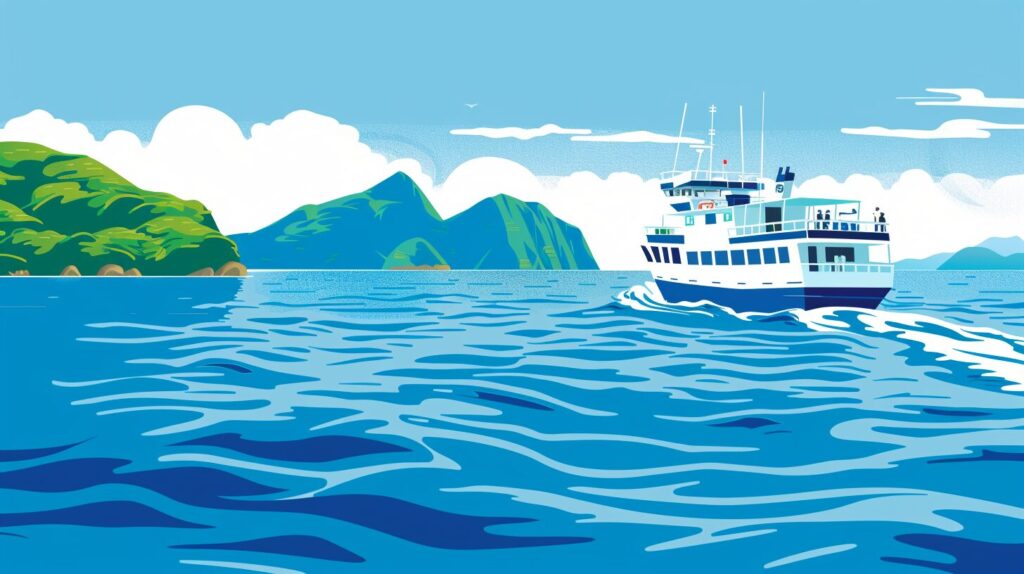
和訳付
会話 / dialogue

Hey Key, have you ever heard of the Ogasawara Islands?
ねぇキー、小笠原諸島って聞いたことある?

Oh, you mean the ones south of Tokyo? I’ve heard about them, but I don’t know much. Why do you ask?
ああ、東京の南にある島のこと?聞いたことはあるけど、詳しくは知らないよ。どうして?

I’ve been really interested in them lately. They’re about 1,000 kilometers from Tokyo and part of the Tokyo Metropolitan area, but they feel so remote.
最近すごく興味があってね。東京から約1,000キロ離れていて、東京都に属しているんだけど、すごく離れた感じがするんだ。

That’s quite far! How do you even get there?
それはかなり遠いね!どうやって行くの?

That’s part of the adventure. There’s no airport, so the only way to go is by a ferry called the Ogasawara Maru. It takes around 24 hours from Takeshiba Pier in Tokyo to Chichijima.
そこが冒険の一部だよ。空港がないから、「おがさわら丸」っていうフェリーで行くしかないんだ。東京の竹芝桟橋から父島まで約24時間かかるよ。

Wow, 24 hours on a boat! But I guess you can enjoy the ocean views along the way.
えー、船で24時間!?でも、海の景色は楽しめそうだね。

Exactly. Some people even see dolphins or whales during the trip. The islands are sometimes called the “Galapagos of the East” because of all the unique species that live there.
その通り。途中でイルカやクジラを見られることもあるんだよ。この島々は、そこにしかいない動植物が多いから「東洋のガラパゴス」って呼ばれることもあるんだ。

That’s pretty amazing. I read somewhere that they’re a UNESCO World Heritage site, right?
それはすごいね。確かユネスコの世界遺産に登録されてるんだよね?

Yeah, they’ve been a World Natural Heritage site since 2011. The islands have a lot of endemic plants and animals, which means they can’t be found anywhere else in the world.
そう、2011年から世界自然遺産に登録されてるんだ。そこには、世界のどこにもない固有の植物や動物がたくさんいるんだよ。

That sounds fascinating. When’s the best time to visit?
それは興味深いね。行くのに一番いい時期はいつ?

From what I’ve learned, spring to early summer and autumn are the best times to go. The weather is nice, and you can do things like snorkeling, diving, and even whale watching.
調べたところだと、春から初夏と秋が一番いいみたい。天気も良いし、シュノーケリングやダイビング、ホエールウォッチングなんかも楽しめるんだ。

I’ve always wanted to go whale watching. What kind of whales can you see there?
ずっとホエールウォッチングしてみたかったんだ。どんなクジラが見られるの?

In winter and early spring, you can spot humpback whales, and sometimes sperm whales in the summer. The islands are a great spot for marine life.
冬から春にかけてはザトウクジラが見られて、夏にはマッコウクジラもいることがあるんだ。この島は海の生物が豊富だよ。

Sounds like a paradise for nature lovers. What else can you do there besides whale watching?
自然好きには天国みたいだね。ホエールウォッチング以外に何ができるの?

Well, the beaches are beautiful, and there are hiking trails with stunning views. You can also explore the forests, which are home to some really rare species of plants and birds. It’s great for people who love the outdoors.
ビーチも美しいし、絶景が見られるハイキングコースもあるよ。森には、珍しい植物や鳥もたくさんいるんだ。アウトドア好きにはぴったりだよ。

It sounds perfect for hiking and exploring. But what about the history? Anything interesting?
ハイキングや探検にはうってつけだね。歴史についてはどう?何か面白い話はある?

Actually, yeah. The islands have a mix of Japanese and Western history. After WWII, the islands were under U.S. control for 23 years before returning to Japan. There are also ruins from the war you can explore.
実はあるよ。島々には日本と西洋の歴史が混ざってるんだ。第二次世界大戦後、23年間アメリカの統治下にあったんだ。その時の遺跡も探検できるよ。

That’s really interesting. I didn’t expect them to have such a unique history. Are there any other islands besides Chichijima?
それは面白いね。そんなユニークな歴史があるとは思わなかった。他に父島以外の島はあるの?

Yes, Hahajima is the other inhabited island. It’s smaller but also worth visiting. If you go, you’ll need to take another ferry from Chichijima.
そう、母島っていう別の有人島もあるんだ。父島より小さいけど、行く価値はあるよ。そこへ行くには、また父島からフェリーに乗らなきゃいけないけどね。

So, it sounds like a pretty exclusive place to visit. You’d have to plan well in advance, especially with the ferry schedules.
それじゃ、かなり特別な場所だね。特にフェリーのスケジュールを考えると、ちゃんと事前に計画しないといけないね。

Exactly. Since the ferry only runs once every few days, you really have to plan your trip carefully. But it seems worth the effort for such a unique experience.
その通り。フェリーは数日に1便しかないから、しっかり計画する必要があるけど、それだけの価値があると思うよ。

I see why you’re so interested. Maybe one day we can go and see those whales and beaches in person.
君が興味を持つのもわかるよ。いつかクジラやビーチを実際に見に行けたらいいね。

Yeah, I’d love to! It’s definitely on my travel list. I’ll keep an eye on the best times to go and gather more details.
うん、ぜひ行きたいよ!僕の旅行リストに入ってるしね。ベストな時期をチェックして、もっと情報を集めておくよ。
概要(世界自然遺産・小笠原諸島の魅力とアクセス)
小笠原諸島

Location and Access
The Ogasawara Islands are located about 1,000 kilometers south of Tokyo. Although they are part of Tokyo, the islands feel very remote. There is no airport on the islands, so the only way to reach them is by ferry. The Ogasawara Maru is the ferry that departs from Tokyo and takes about 24 hours to reach Chichijima, the main island. The ferry runs only a few times a week, so planning is important.
小笠原諸島は東京の南約1,000キロに位置しています。東京都に属していますが、とても遠く感じられます。島には空港がないため、行く手段はフェリーのみです。おがさわら丸というフェリーが東京から出発し、主要な島である父島まで約24時間かかります。フェリーは週に数回しか運航していないので、事前の計画が重要です。
Unique Ecosystem
The Ogasawara Islands are known for their unique ecosystem. Since the islands were never connected to any continent, many plants and animals there are endemic, meaning they can only be found on these islands. Because of this rich biodiversity, the islands are often called the “Galapagos of the East” and were named a UNESCO World Natural Heritage site in 2011.
小笠原諸島は独特の生態系で知られています。この島々は一度も大陸とつながったことがないため、固有の植物や動物が多く生息しています。そのため、この豊かな生物多様性から「東洋のガラパゴス」とも呼ばれ、2011年にはユネスコの世界自然遺産に登録されました。
Activities and Best Season
Visitors can enjoy activities such as snorkeling, diving, and whale watching. The best time to visit is in spring or early summer, or in autumn when the weather is pleasant. During winter and early spring, humpback whales can be seen, while sperm whales are sometimes spotted in summer.
訪れる人は、シュノーケリング、ダイビング、クジラウォッチングなどのアクティビティを楽しむことができます。訪れるのに最適な時期は、春から初夏、または天気が快適な秋です。冬から春にかけてはザトウクジラが見られ、夏にはマッコウクジラが時折観察されます。
History
The islands also have an interesting history. After World War II, they were under U.S. control for 23 years before being returned to Japan. Some war ruins can still be explored on the islands.
この島々には興味深い歴史もあります。第二次世界大戦後、23年間アメリカの統治下にあり、その後日本に返還されました。島内には、今でも探索できる戦争遺跡が残されています。
10の質問(小笠原諸島を知るための基本知識)
1: What are the Ogasawara Islands?
小笠原諸島とは何ですか?
The Ogasawara Islands are a group of islands located about 1,000 kilometers south of Tokyo. They are known for their unique ecosystem and are part of Tokyo despite being very remote.
小笠原諸島は、東京の南約1,000キロに位置する島々のことで、ユニークな生態系を持ち、東京都に属していますが、非常に離れた場所にあります。
2: How can you travel to the Ogasawara Islands?
小笠原諸島へはどうやって行けますか?
There is no airport on the islands, so the only way to travel there is by the Ogasawara Maru ferry, which takes about 24 hours from Tokyo’s Takeshiba Pier to Chichijima.
島には空港がないため、「おがさわら丸」というフェリーで行くしかなく、東京の竹芝桟橋から父島まで約24時間かかります。
3: Why are the Ogasawara Islands called the “Galapagos of the East”?
なぜ小笠原諸島は「東洋のガラパゴス」と呼ばれるのですか?
The Ogasawara Islands are called the “Galapagos of the East” because they have many endemic species, meaning animals and plants that can only be found on these islands, similar to the Galapagos Islands.
小笠原諸島には固有種が多く生息しており、ガラパゴス諸島のように、これらの島々でしか見られない動植物が存在するため「東洋のガラパゴス」と呼ばれています。
4: What activities can you do on the Ogasawara Islands?
小笠原諸島ではどのようなアクティビティが楽しめますか?
Popular activities on the islands include snorkeling, diving, and whale watching. Visitors can enjoy the clear waters, beautiful beaches, and rich marine life.
人気のあるアクティビティには、シュノーケリング、ダイビング、そしてクジラウォッチングがあります。訪問者は透明な海、美しいビーチ、そして豊かな海洋生物を楽しめます。
5: When is the best time to visit the Ogasawara Islands?
小笠原諸島を訪れるのに最適な時期はいつですか?
The best time to visit is in spring to early summer and in autumn. During these seasons, the weather is pleasant, and you can enjoy activities like snorkeling and diving.
春から初夏、または秋が訪れるのに最適な時期です。これらの季節は天気が良く、シュノーケリングやダイビングなどのアクティビティを楽しむことができます。
6: What kinds of whales can you see around the Ogasawara Islands?
小笠原諸島周辺で見られるクジラの種類は何ですか?
In winter and early spring, visitors can see humpback whales, while in summer, sperm whales are sometimes spotted near the islands.
冬から春にかけてはザトウクジラが見られ、夏には時折マッコウクジラが島の近くで観察されます。
7: What makes the ecosystem of the Ogasawara Islands unique?
小笠原諸島の生態系がユニークな理由は何ですか?
The islands were never connected to any continent, allowing many species of plants and animals to evolve separately. This has resulted in a unique ecosystem with many endemic species.
この島々は一度も大陸とつながったことがないため、多くの植物や動物が独自に進化しました。その結果、固有種が多く存在するユニークな生態系が形成されました。
8: Why were the Ogasawara Islands designated as a UNESCO World Natural Heritage site?
小笠原諸島がユネスコ世界自然遺産に登録された理由は何ですか?
The Ogasawara Islands were designated as a UNESCO World Natural Heritage site in 2011 because of their rich biodiversity and large number of endemic species that need protection.
小笠原諸島は、その豊かな生物多様性と保護が必要な多くの固有種が存在するため、2011年にユネスコ世界自然遺産に登録されました。
9: What is the historical significance of the Ogasawara Islands?
小笠原諸島の歴史的な重要性は何ですか?
After World War II, the islands were under U.S. control for 23 years before being returned to Japan. There are also war ruins on the islands that visitors can explore.
第二次世界大戦後、23年間アメリカの統治下にあり、その後日本に返還されました。島内には訪問者が探索できる戦争遺跡も残されています。
10: How often does the Ogasawara Maru ferry operate?
おがさわら丸のフェリーはどれくらいの頻度で運航していますか?
The Ogasawara Maru ferry runs only a few times a week, depending on the season, so travelers need to plan their trips carefully.
おがさわら丸は季節によって週に数回しか運航していないため、旅行者は慎重に計画を立てる必要があります。
words & phrases
英会話ダイアローグと関連情報に出てきた単語・フレーズです(例文は各3つ)。

endemic : 形容詞
意味: 特定の地域に固有の、生息する。Only found in a particular place or area.
(小笠原諸島に固有の動植物を指して使用)
例文:
- Many species on the islands are endemic to Ogasawara.
「島の多くの種は小笠原諸島に固有です。」 - Malaria is endemic in some tropical regions.
「マラリアは一部の熱帯地域に固有の病気です。」 - The kangaroo is endemic to Australia.
「カンガルーはオーストラリアに固有の動物です。」
spot : 動詞
意味: 見つける、発見する。To see or notice something, especially something difficult to see.
(島周辺でクジラやマッコウクジラが見られる、という意味で使用)
例文:
- You can sometimes spot sperm whales near the islands.
「島の近くで時々マッコウクジラを見つけることができます。」 - She spotted a rare bird in the forest.
「彼女は森の中で珍しい鳥を見つけました。」 - Can you spot the difference between these two pictures?
「この二つの写真の違いがわかりますか?」
sperm : 名詞
意味: マッコウクジラ。Sperm whale, a large species of whale.
(小笠原諸島周辺で見られるクジラの一種を指して使用)
例文:
- Sperm whales are often spotted near the Ogasawara Islands in the summer.
「夏には小笠原諸島の近くでマッコウクジラがよく見られます。」 - The sperm whale is the largest toothed predator in the world.
「マッコウクジラは世界で最も大きな歯を持つ捕食者です。」 - A group of sperm whales was seen near the shore yesterday.
「昨日、海岸近くでマッコウクジラの群れが見られました。」
inhabited : 形容詞
意味: 人が住んでいる。Lived in by people.
(文脈での使用:小笠原諸島において、有人島である父島や母島を指して使用)
例文:
- Chichijima is the most inhabited island in the Ogasawara group.
「父島は小笠原諸島で最も多くの人が住む島です。」 - This area has been inhabited for thousands of years.
「この地域は数千年間、人が住んでいました。」 - The island is inhabited mainly by fishermen.
「その島には主に漁師が住んでいます。」
exclusive : 形容詞
意味: 限られた人だけが利用できる、独占的な。Available only to a particular group of people or area.
(小笠原諸島を訪れることが特別で計画が必要なことを表現)
例文:
- Visiting the Ogasawara Islands feels like an exclusive experience.
「小笠原諸島を訪れることは特別な体験のように感じられます。」 - This resort offers exclusive access to a private beach.
「このリゾートは専用ビーチへの特別なアクセスを提供しています。」 - The club is exclusive to members only.
「そのクラブは会員限定です。」
詳細情報 / Further Info
関連記事(知床、屋久島、白神山地)
